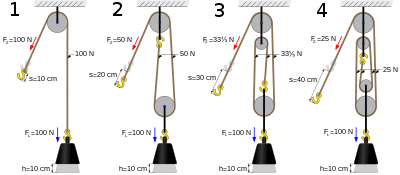The golden rule of mechanics
The golden rule of mechanics expresses the content of the law of conservation of energy for simple examples of mechanics . Galileo Galilei formulated it in 1594: "What you save in energy , you have to increase the way ".
In the case of force converters ( lever , pulley block , inclined plane ), the aim is often to replace a force that has to be applied (e.g. the weight force to lift an object) with a smaller one. In simple examples (the force acts exactly in the direction of movement of the body, friction losses are neglected may) can be spent on the work , so the change in energy as the product of force and displacement calculate:
In words: "Work is power times way".
From the conservation of the total energy it follows that the change in one factor causes a corresponding reciprocal proportional change in the other factor. With the same work, the path becomes greater with a smaller force and the path becomes smaller with a greater force.
example
With an ordinary factor block and tackle with load-bearing pieces of rope, the force required to lift an object with the weight is only . In order to overcome a height difference of , however, the rope length has to be pulled. The energy to be used is then (provided that friction losses are neglected):

|
||||||
| 1 | 0.10 m | 100 N | 100 N | 0.10 m | 10 y | |
| 2 | 50 N | 0.20 m | 10 y | |||
| 3 | 33⅓ N. | 0.30 m | 10 y | |||
| 4th | 25 N. | 0.40 m | 10 y |
The following applies here: "What you save in strength you have to add to the rope length."
Web links
- The "golden rule of mechanics" with several simple examples at student level ( LEIFI )
Individual evidence
- ^ Basic knowledge of school physics , Duden Paetec, Berlin 2010











